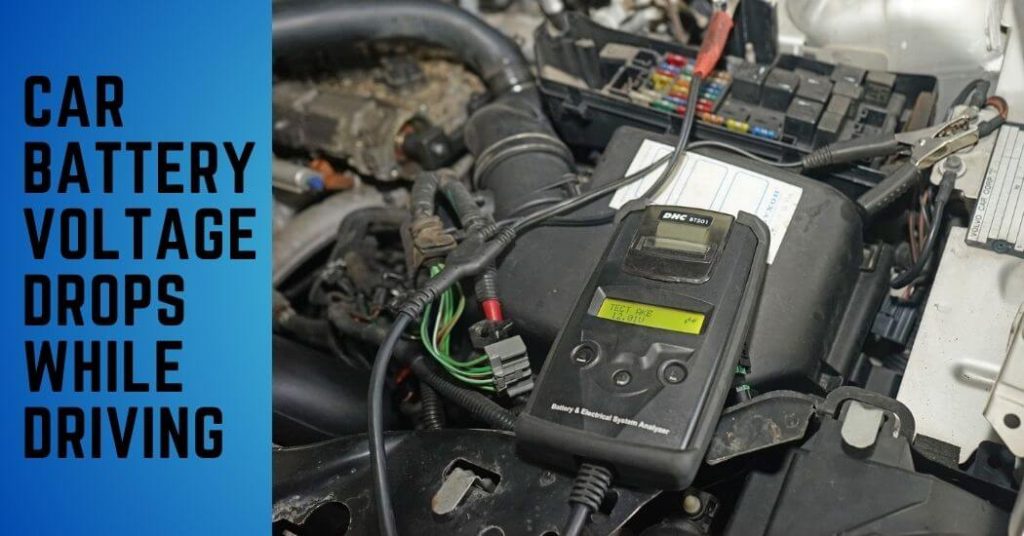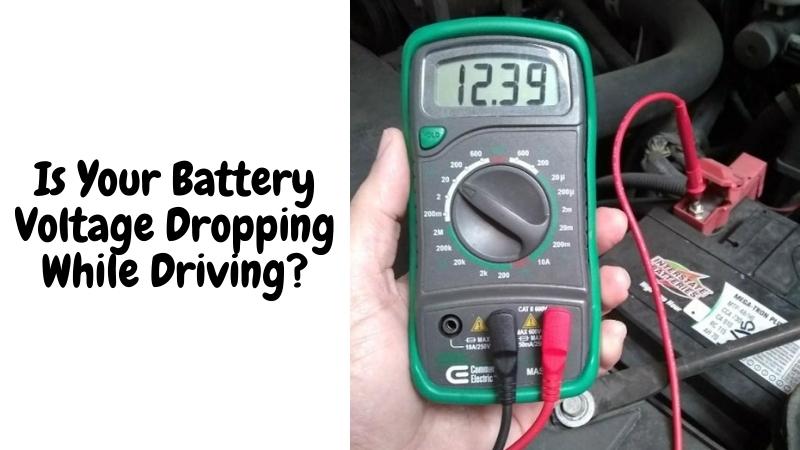Last Updated on July 26, 2023 by Mark S. Taylor
Car battery voltage drops while driving due to various factors such as a faulty alternator, loose battery connections, or high electrical loads. These issues can cause the battery voltage to drop, leading to a loss of power and potential vehicle breakdowns.
To avoid this, it is essential to regularly check and maintain your vehicle’s battery, alternator, and connections to ensure stable voltage levels while driving. Taking preventive measures can help prolong the life of your car battery and ensure a smooth driving experience.
So, let’s explore the reasons behind car battery voltage drops while driving and how to prevent this issue.

Contents
**Understanding The Causes Of Car Battery Voltage Drops**
Car Battery Voltage Drops While Driving
Have you ever wondered why your car battery voltage drops while driving? It can be both frustrating and worrisome when your car’s battery doesn’t seem to be performing at its optimal level. Understanding the causes of car battery voltage drops is essential in order to address the issue effectively.
In this section, we will delve into the battery basics, factors contributing to voltage drops, and the impact of temperature on battery performance.
Read more: The Best Car Battery
Battery Basics: How Car Batteries Work
Car batteries are essential components that provide electrical energy for starting the engine, powering the lights, and running various electrical systems in your vehicle. Here are the key points to know about how car batteries work:
- Car batteries operate on a chemical reaction between lead plates and sulfuric acid, converting chemical energy into electrical energy.
- The battery’s voltage powers the starter motor ignites the engine, and supplies electricity to other components in the vehicle.
- Car batteries consist of six cells connected in series, with each cell providing approximately 2.1 volts, resulting in a total voltage of 12.6 volts for a fully charged battery.
Factors Contributing To Voltage Drops
Voltage drops in car batteries can occur due to several factors. Understanding these factors can help you troubleshoot and address voltage drop issues effectively. Consider the following key points:
- Age and condition of the battery: As car batteries age, their capacity to hold a charge diminishes, leading to voltage drops. Similarly, if the battery is in poor condition or has been damaged, it may not deliver the required voltage.
- Excessive electrical load: Using various electrical components simultaneously, such as the air conditioning, headlights, and sound system, can place a heavy load on the battery, causing voltage drops.
- Faulty alternator: The alternator is responsible for charging the battery while the engine is running. A malfunctioning alternator can fail to supply sufficient charge, leading to voltage drops.
- Loose or corroded connections: Loose or corroded battery terminals and connections can hinder the flow of electrical current, resulting in voltage drops.
The Impact Of Temperature On Battery Performance
Temperature plays a significant role in the performance of car batteries. Extreme hot or cold weather conditions can affect the battery’s ability to deliver its full voltage. Consider the following points:
- Cold weather: In colder temperatures, the chemical reaction in the battery slows down, reducing its overall performance. This can lead to lower voltage outputs and difficulty in starting the engine.
- Hot weather: Excessive heat can accelerate the rate of chemical reactions inside the battery, causing it to discharge faster. High temperatures can also lead to increased evaporation of battery fluid, further impacting its performance and potentially shortening its lifespan.
It is important to note that while some voltage drop during driving is normal, prolonged and significant drops may indicate an underlying issue with your battery or electrical system. Regular maintenance and periodic check-ups are crucial in ensuring optimal battery performance.
By understanding the battery basics, factors contributing to voltage drops, and the impact of temperature on battery performance, you can take proactive measures to prevent voltage drops and maintain your car’s electrical system in top condition. So, next time you experience a voltage drop, you will be well-equipped to diagnose the issue and take appropriate action.
**Signs And Symptoms Of Car Battery Voltage Drops**
Car Battery Voltage Drops While Driving
Signs And Symptoms Of Car Battery Voltage Drops
Dimming headlights and interior lights:
- One of the common signs of a car battery voltage drop is the dimming of headlights and interior lights while driving.
- Dimming headlights can be noticed during nighttime driving when the battery struggles to supply sufficient voltage for proper illumination.
- Interior lights may also become dimmer, affecting visibility within the vehicle.
Difficulty starting the vehicle:
- Another sign of a car battery voltage drop is difficulty starting the vehicle, especially in cold weather conditions.
- When the battery voltage drops, it weakens the starting power, causing the engine to crank slowly or fail to start altogether.
- You may notice a clicking sound, indicating a low charge that hinders the ignition process.
Malfunctioning electrical components:
- A voltage drop in the car battery can lead to the malfunctioning of various electrical components in the vehicle.
- You might experience issues with the power windows, door locks, or even the radio. These components may operate sporadically or not at all.
- Dimming dashboard lights or erratic readings on the instrument panel are also common symptoms of a voltage drop.
To prevent being stranded on the road or facing unexpected electrical failures, it’s important to be aware of these signs and symptoms of a car battery voltage drop. Regularly checking your car’s battery voltage and ensuring it remains within the appropriate range can help maintain optimal performance and prevent potential issues down the road.
Read More: How to Fix a Battery Dead Cell
**Troubleshooting Tips For Car Battery Voltage Drops**
Troubleshooting Tips For Car Battery Voltage Drops
Regular battery maintenance and inspections:
- Engage in regular battery maintenance to identify potential issues early on.
- Inspect the battery for signs of damage or wear and tear regularly.
- Monitor the battery voltage regularly to identify any drops.
Checking for loose or corroded connections:
- Ensure all connections are tight and secure.
- Check for any signs of corrosion on the battery terminals.
- Clean the terminals and connections to improve conductivity.
Cleaning battery terminals:
- Remove the battery cables from the terminals.
- Use a mixture of baking soda and water to clean the terminals and cables.
- Scrub the terminals gently using a wire brush to remove any corrosion.
Ensuring proper battery fluid levels:
- Check the battery fluid levels regularly to ensure they are within the recommended range.
- Add distilled water if necessary to maintain optimal levels.
- Avoid overfilling the battery as it can lead to acid spills.
Testing battery voltage while driving:
- Use a multimeter to measure the battery voltage while the car is running.
- Connect the multimeter to the battery terminals and observe the voltage reading.
- If the voltage drops below the recommended range, further troubleshooting is necessary.
Using a multimeter to measure voltage:
- Set the multimeter to the voltage testing mode.
- Connect the positive lead to the positive terminal and the negative lead to the negative terminal.
- Observe and record the voltage reading displayed on the multimeter.
Identifying abnormal voltage fluctuations:
- Look for sudden and significant drops or spikes in battery voltage.
- Abnormal fluctuations may indicate underlying issues that need to be addressed.
- Consult a professional if you notice any irregularities in the voltage readings.
Identifying and addressing common issues:
Faulty alternator:
- A faulty alternator can cause battery voltage drops while driving.
- Look for signs such as dim headlights or difficulty starting the car.
- Replace the alternator if necessary to resolve the issue.
Parasitic drain:
- Parasitic drain occurs when there is an excessive draw on the battery even when the car is not running.
- Conduct a parasitic drain test to identify any components or systems causing the drain.
- Repair or replace the problematic component to prevent further voltage drops.
Battery sulfation:
- Sulfation occurs when lead sulfate crystals accumulate on the battery plates.
- This can lead to reduced battery capacity and voltage drops.
- Use a battery desulfator or consult a professional to restore the battery’s performance.
Taking precautions to prevent voltage drops:
Reducing electrical load:
- Minimize the use of electrical accessories while driving.
- Turn off lights, radio, and other non-essential electronics to reduce the strain on the battery.
- Unplug any devices connected to the car’s power outlets when not in use.
Upgrading the battery or alternator if necessary:
- Consider upgrading to a higher-capacity battery.
- A higher-rated alternator can also provide better charging capabilities.
- Consult a professional to determine if an upgrade is necessary for your vehicle.
Remember, troubleshooting car battery voltage drops is crucial for maintaining proper battery function and preventing unexpected breakdowns. Regular inspections, timely maintenance, and addressing any issues promptly can help keep your battery in optimal condition.
Frequently Asked Questions On Car Battery Voltage Drops While Driving
Why Does The Car Battery Voltage Drop While Driving?
While driving, the car battery voltage may drop due to a faulty alternator, loose or corroded battery connections, or excessive electrical load. It is essential to check the alternator, and battery connections, and reduce the electrical load to ensure optimal battery performance.
How Can A Faulty Alternator Affect Car Battery Voltage?
A faulty alternator may not provide sufficient charging power to the battery, leading to a drop in voltage while driving. This can result in dimming lights, weak engine performance, and ultimately a dead battery. Timely inspection and replacement of a faulty alternator can prevent such troubles.
Why Are Loose Battery Connections Responsible For Voltage Drops?
Loose or corroded battery connections can hamper the flow of electricity and cause voltage drops. This can lead to poor battery performance, startup issues, and even potential breakdowns. Regularly checking and tightening battery connections is highly recommended to maintain optimal voltage levels.
Conclusion
To recap, it is crucial to monitor your car battery voltage while driving to ensure its optimal performance. By understanding the reasons behind voltage drops and taking preventative measures, you can avoid getting stranded on the road. Regularly checking your battery’s charge and voltage levels, especially before long drives or extreme weather conditions, will help you identify any potential issues before they escalate.
Keeping your car battery terminals clean, ensuring proper connections, and driving regularly can also contribute to the battery’s overall health. Remember, a healthy car battery is essential for the smooth operation of your vehicle’s electrical systems. By following these tips, you can prolong the lifespan of your battery and minimize the chances of unexpected breakdowns.
Start paying attention to your car battery voltage today and enjoy hassle-free drives in the future.

